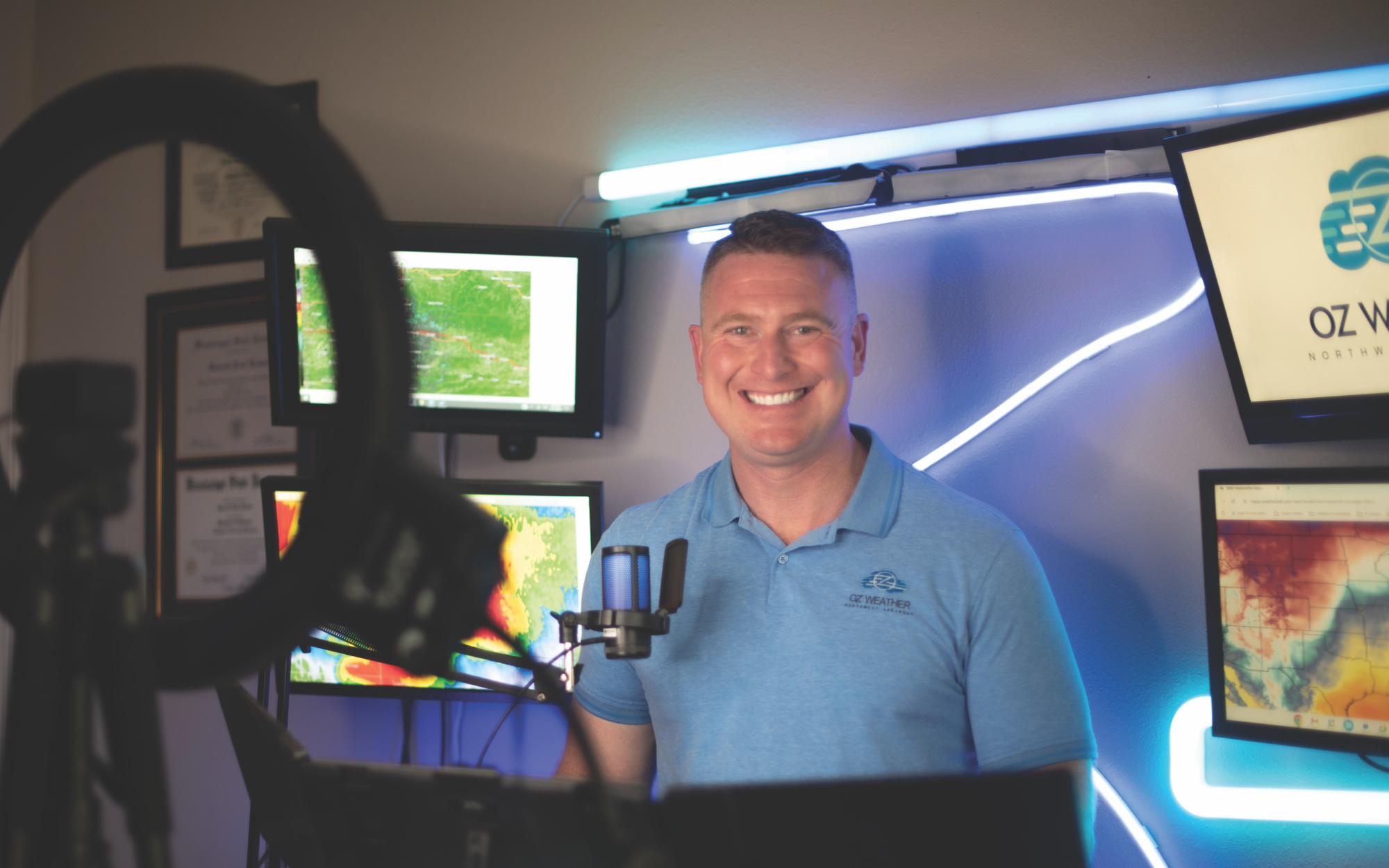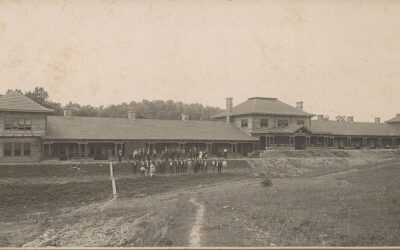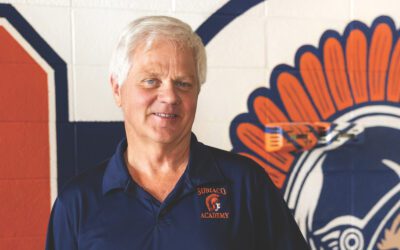Garrett Lewis sits inside Awaken Coffee in Alma, Arkansas. The dress shirts of his TV weather days are history. The bottom of a red and black tattoo shows beneath the edge of his short-sleeved shirt, and as he sips his coffee, he talks about life after forty.
The former chief meteorologist at KFSM-TV 5 spent his early years in Utah. He loved the snow and often took his sled to school. When he was old enough to dial a telephone, he’d call local DJs to talk about the weather, but they had little interest in a nerdy kid. Garrett laughs. “The DJs would just hang up on me.” It’s hard for him to remember a time when he didn’t want to be involved with the weather.
“It was the mystery of it,” Garrett says. “It’s the curiosity in me, being surprised by what the weather does. That’s what fascinated me.”
By seventh grade, Garrett was attending school in Alma. In high school, he played defensive end on the Airedale football team and was part of Coach Frankie Vines’ Class AAA State Championship team in 1997 and 1998.
Garrett was an anomaly: part jock, part weather geek, so he never quite fit any mold. In his junior year, Garrett’s History Day project was about Doppler radar, a key component in forecasting severe weather. Bur Edson, then-anchor/news director at KFSM-TV, was judging. Bur was so impressed with Garrett that he told him to stay in touch.
Garrett interned at KFSM, starting at nineteen, while earning his off-campus bachelor’s degree from Mississippi State University. In July 2001, Bur Edson hired him to be part of the KFSM-TV weather team.
One night, when Garrett’s severe weather coverage went wall-to-wall (meaning no breaks, not even for commercials), the mix of searing studio lights and adrenaline caused him to perspire. So, he rolled up his sleeves, hoping for a bit of relief. While he was too busy to find any subliminal meaning in the act, his viewers found plenty. From then on, his rolled-up sleeves became a scale of sorts, a harbinger of what was to come. The higher the sleeve, the greater the risk. When Garrett’s sleeves reached his elbows, viewers knew to duck and cover.
Being on TV is a “best of times, worst of times” proposition. People recognize you in public, yay! People recognize you in public, ugh. Your co-workers are typically curious, interesting people. You’re never bored; there’s too much going on. But when you work “nightside,” you show up in the early afternoon and stay until at least eleven p.m. You have to be “on” to be on TV, so it takes time to turn “off,” meaning you’re not going to sleep anytime soon. You miss every nighttime event. You miss every afternoon event. You work all the schedules eventually: late nights, early mornings, weekends, every holiday. You’re on call 24/7. So, you learn to cuss—a lot.
In May 2011, an EF-4 tornado with winds up to 170 mph ripped its way through Franklin and Johnson Counties, destroying the town of Denning. That event was later called the Altus-Denning storm. Garrett, reminiscing, rakes his hand across his mouth and takes a ragged breath.”
“The Altus-Denning tornado—it was one of those storms where you knew people were going to die—you could see it on the ground. And it was moving right toward Joe’s [then-KFSM fellow meteorologist Joe Pennington] mom’s house. Seeing Joe, seeing the storm on radar, knowing how intense it was, was the hard one.
Joe Pennington’s mom was spared, but three other people died.
After the storm abated, Garrett went to see the damage. In news, the aftermath of a twister is often described as looking like a war zone. That’s because no other description feels as apt. As Garrett surveyed the piles of debris, the uprooted trees, the mangled barns, his heart splintered.
“I’ve been asked, how do you deal with seeing that? In my case, I didn’t. I stuffed it down and went on… For a while, in 2017 and 2018, I drank a lot. I used alcohol to go to sleep… I tried to stop drinking on my own, and that’s when I realized I had a problem.”
Garrett tried a Naltrexone-assisted treatment called the Sinclair Method that helps you progressively decrease the amount of alcohol you use. “This sounds crazy, but you drink yourself sober. It [Naltrexone] takes the dopamine hit away,” Garrett says. “You can drink, but you don’t get anything, and after a while, you say, ‘This tastes like crap; what am I doing?'”
As a reminder of that time and his victory over it, Garrett had a red and black Naltrexone molecule tattooed on his bicep. Raising his sleeve, he says, “It reminds me where I am in my journey.”
By 2019, he was in a self-reflective stage. He was thankful for everything TV had given him—he’d even been a guest on Dr. Phil—but honest about everything it had taken away. He’d missed too many moments with his sweet wife, Ashley. He’d missed too many of his son’s and daughter’s milestones. He had to slow down.
July 30, 2021, was Garrett’s last day as chief meteorologist at KFSM-TV. He’d made it twenty years in a career that’s often short-lived. He had only one plan. He and his family rented a house in Florida for two months. The Lewises were going to celebrate their family, the weather be damned.
In September of 2021, he found his new career. Garrett is now the Assistant Vice President of Commercial Lending at First National Bank of Northwest Arkansas. He’s the notepad and pen guy, raising his hand at every staff meeting. He has so much to learn, which keeps him both humble and interested.
Still, part of him missed forecasting. Once he’d regrouped, he solicited advice from other meteorologists. He talked to tech experts, and a plan evolved. There was a way to do weather that gave Garrett what he loved: the science, the ability to keep communities safe, the connection with the public. There was no need for a complicated weather studio or hours spent making graphics. Weathercasting could be a hobby instead of a job, which suited Garrett just fine.
On Superbowl Sunday, during halftime, he launched his new, free weather app called Oz Weather. Oz is both a play on The Wizard of Oz and the Ozarks. Garrett produces his morning weathercast, also available on Facebook and YouTube, from his home in Rogers. He laughs. “What you can’t see are the dogs at my feet and a pile of laundry in the corner.” His FNB bosses have been great about it. So far, it hasn’t taken him away from work, but if severe weather threatens, they’ve given him the okay to cover it.
The frenetic pace of TV is gone. It shows in everything Garrett does, like listening to Brené Brown’s motivational leadership podcasts and reading collections of poetry. There was a time when Garrett’s tapped his foot incessantly. His life was a whirlwind. You could see his mind working, traveling in twelve different directions. He might be with you, but he wasn’t “with you.”
“I can be present,” he says, and Garrett is overcome with emotion. He is grateful for the life he has. For his family. For dipping his toe back in the sea of weather, just for the heck of it. For a job that lets him be part of a community while still having the time to do so many other things he loves.
Garrett’s road to Oz was never gold, but the twister that led there was spot on. The storm taught him plenty. Everything really does work out in the end. It did for Dorothy. And it certainly did for the little kid who stood on his tiptoes to call radio stations, hoping they’d let him forecast the weather. After all, he knew a lot about snow. He’d sailed across it on his very own sled.
The Oz Weather app is available for free from Apple and Google stores. You can follow Oz Weather on Facebook from Garrett Lewis’s page. On YouTube, subscribe to Oz Weather.
WORDS Marla Cantrell
IMAGES courtesy Ashley Lewis




